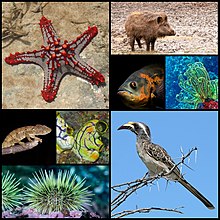
Back Deuterostomia Afrikaans Neumünder ALS ثانويات الفم Arabic ثانويات الفم ARZ Deuterostomia AST Sonağızlılar Azerbaijani Икенсел ауыҙлылар Bashkir Другаснаротыя Byelorussian Другаснаротыя BE-X-OLD Вторичноустни Bulgarian
| Deuterostomes | |
|---|---|

| |
| Diversity of deuterostomes | |
| Scientific classification | |
| Domain: | Eukaryota |
| Kingdom: | Animalia |
| Clade: | ParaHoxozoa |
| Clade: | Bilateria |
| Clade: | Nephrozoa |
| Superphylum: | Deuterostomia Grobben, 1908 |
| Clades | |
Deuterostomes (from Greek: lit. 'mouth second') are bilaterian animals of the superphylum Deuterostomia (/ˌdjuːtərəˈstoʊmi.ə/),[3][4] typically characterized by their anus forming before the mouth during embryonic development. Deuterostomia is further divided into 4 phyla: Chordata, Echinodermata, Hemichordata, and the extinct Vetulicolia known from Cambrian fossils. The extinct clade Cambroernida is also thought to be a member of Deuterostomia.
In deuterostomy, the developing embryo's first opening (the blastopore) becomes the anus and cloaca, while the mouth is formed at a different site later on. This was initially the group's distinguishing characteristic, but deuterostomy has since been discovered among protostomes as well.[5] This group is also known as enterocoelomates, because their coelom develops through enterocoely.
Deuterostomia's sister clade is Protostomia, animals that develop mouth first and whose digestive tract development is more varied. Protostomia includes the ecdysozoans (panarthropods, nematoids, penis worms, mud dragons etc.) and spiralians (mollusks, annelids, flatworms, rotifers, arrow worms, etc.), as well as the extinct Kimberella. Together with Protostomia and their outgroup Xenacoelomorpha, they constitute the large infrakingdom Bilateria, i.e. animals with bilateral symmetry and three germ layers.
- ^ Fedonkin, M. A.; Vickers-Rich, P.; Swalla, B. J.; Trusler, P.; Hall, M. (2012). "A new metazoan from the Vendian of the White Sea, Russia, with possible affinities to the ascidians". Paleontological Journal. 46 (1): 1–11. Bibcode:2012PalJ...46....1F. doi:10.1134/S0031030112010042. S2CID 128415270.
- ^ Han, Jian; Morris, Simon Conway; Ou, Qiang; Shu, Degan; Huang, Hai (2017). "Meiofaunal deuterostomes from the basal Cambrian of Shaanxi (China)". Nature. 542 (7640): 228–231. Bibcode:2017Natur.542..228H. doi:10.1038/nature21072. PMID 28135722. S2CID 353780.
- ^ Wade, Nicholas (30 January 2017). "This Prehistoric Human Ancestor Was All Mouth". The New York Times. Retrieved 31 January 2017.
- ^ Han, Jian; Morris, Simon Conway; Ou, Qiang; Shu, Degan; Huang, Hai (2017). "Meiofaunal deuterostomes from the basal Cambrian of Shaanxi (China)". Nature. 542 (7640): 228–231. Bibcode:2017Natur.542..228H. doi:10.1038/nature21072. ISSN 0028-0836. PMID 28135722. S2CID 353780.
- ^ Martín-Durán, José M.; Passamaneck, Yale J.; Martindale, Mark Q.; Hejnol, Andreas (2016). "The developmental basis for the recurrent evolution of deuterostomy and protostomy". Nature Ecology & Evolution. 1 (1): 0005. doi:10.1038/s41559-016-0005. PMID 28812551. S2CID 90795.
© MMXXIII Rich X Search. We shall prevail. All rights reserved. Rich X Search